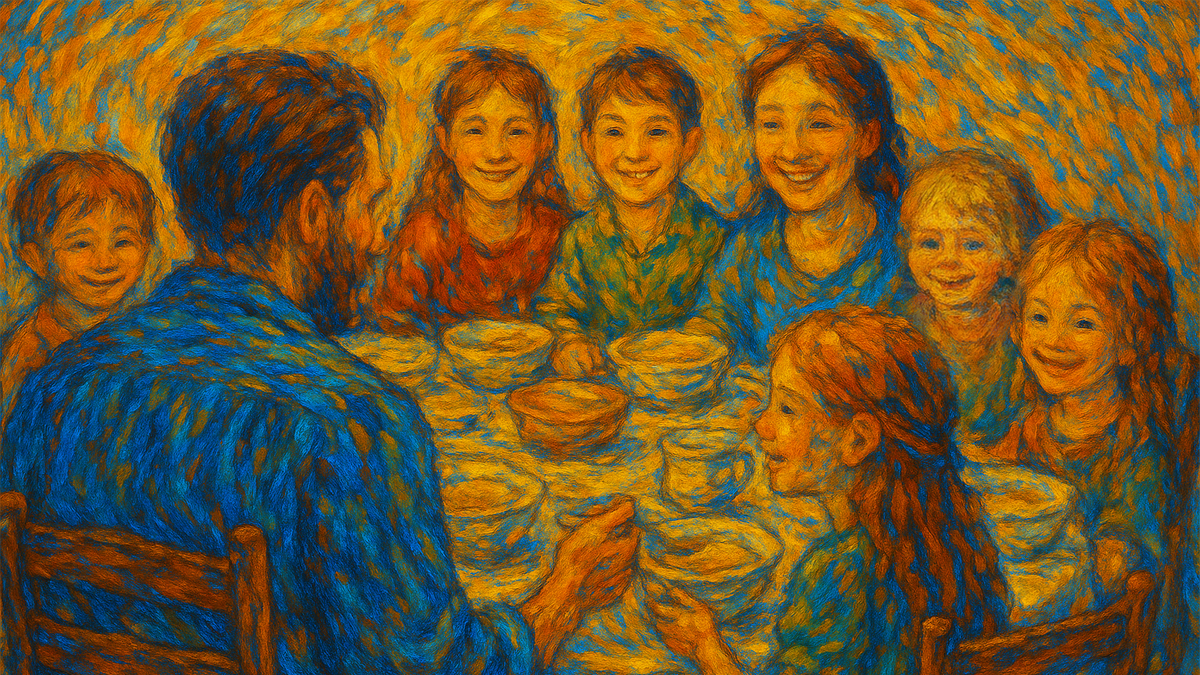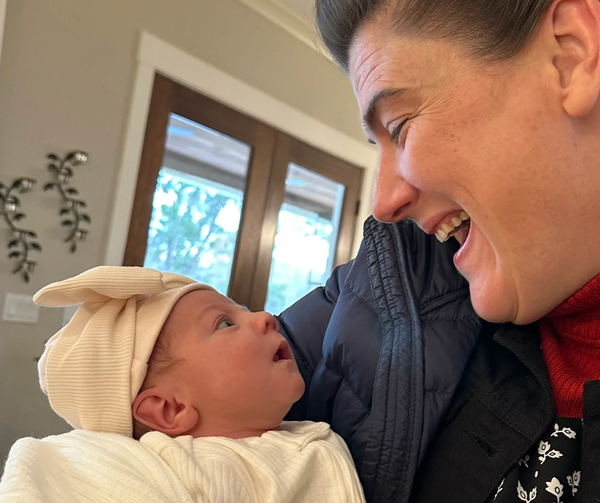What Is a Community?
What is community—and how do we nourish it? From dinner conversations to ancient allegories and modern distractions, this reflection explores how spiritual and emotional “soul food” shapes true connection, and why real community must be chosen, protected, and cultivated daily.

Is it a kibbutz, a commune, a social network, a church, a cult? In my travels, I’ve often found that this is one of the more central questions. But if we can’t define what a community is, how can we protect it or even hope to realize it by any recognizable standard? This is what I want to explore in this article.
But first, some reflections from yesterday’s supper.
More than a Meal
As we gathered around the dinner table last night, it wasn’t just the immediate family. We were joined by a sister-in-law and her two teen daughters, a newly made friend from out of the country, and one other friend. “What brought us to the table,” I asked? Was it the chicken soup? Or even Beck’s flaky, raisin-studded biscuits that she so lovingly created? Both were delicious, yes. But it was something more.
What kept us at the table, long after the bowls were empty and the meal concluded, wasn’t just the food. We spent over an hour discussing everything from song writing to high-school assignments (theology essays, history papers, and Tina’s math). One of the key topics that emerged from our conversation was my recent allegory, “The Pen and the Mountain.” With teenagers from three different grades around the table, it was fascinating to hear how each of them had discussed the metaphor within their study groups. One of the key questions that arose was, “What was the duck feed?”
I had written the earliest form of this allegory back in 2014, sitting then at the kitchen table of our tiny log cabin, watching our flock of white Pekin ducks, fattened for the freezer. One of the children had been startled, “Daddy, Daddy! The ducks are flying! They’re going to get out!” But as we observed them, we saw that while they could flap their wings and lift off the ground, they could never soar higher than the fence. They were too heavy, too well-fed, too reliant on the system that they thought was providing for them. But in reality, it was preparing them for slaughter.
It wasn’t a new idea—just a fresh perspective on an old metaphor. So I wrote it down that day. And last night, around the supper table, we asked, “What is the duck feed?” I explained to them that the “duck feed” represents the spiritual, emotional, and relational nourishment no human can live without. We are not merely physical beings; we are spiritual, metaphysical beings. We need nourishment for the mind, the heart, the imagination, and the soul.
The Spiritual and Emotional Nourishment We Need
I told them that we cannot truly discuss independence or freedom without first considering what sustains us, not just in terms of food, like our chicken soup, but in the deeper sense of what we feed our hearts, minds, and souls. I reminded them that none of them have ever absorbed TV shows, touched video games, or known affirmation from social media likes and clicks. These are the “cheap” and “easy” forms of nourishment for the soul. That, I said, is the “duck feed” in my metaphor published last week.
Yet, as we sat and talked, our emotions ranged from intense laughter over a child’s funny comment to tears as we reflected on the ideas we had been discussing. We had fed our bodies with wholesome food, grown right on our own farm, prepared with our own hands. But we were also feeding our hearts and minds in a way that was harder to come by than the “TV dinners” of modern entertainment—nothing like the digital perfection we’re bombarded with daily. There was no manipulation of senses through artificial, digital means. And I explained, “Even at the table, we were working for our soul food.”
Fast Food as Soul Food
We all know the reality of our culture today: fast food. It’s quick, convenient, and tantalizing. It seems to offer everything we want in a moment of weakness—ease, speed, and a rush of satisfaction. But what happens when we apply this logic to the food of the soul? What does our modern culture provide when it comes to emotional and spiritual nourishment? It's not hard to see the comparison. The same way fast food has become ubiquitous in our culture, spiritual and emotional sustenance has also become quick, shallow, and instant. The marketing tactics are the same: feed us what is cheapest, most attention-grabbing, and easiest to consume. And most tend to fall for it without a second thought.
I still remember sitting in a pizza joint when Aaron was just four years old. Since we don’t have a TV at home, the kids are always fascinated by those glowing screens—flashing and zipping with endless motion. Four-year-old Aaron could barely focus on his food, his head craned over his shoulder in stunned amazement, gawking at the absurdity of the television. His mother gently corrected him, “Aaron, sit up straight, look ahead, lean over your plate, and stop staring at the TV.” He reached up with his hand and physically turned his own head away, explaining, “I don’t want to look at it, but it keeps grabbing my eyes!”
Now imagine—even at nine years old—what he would have missed from last night’s supper conversation if there had been a TV in the next room: goofy cartoons pulling at his laughter or fantastical tales hijacking his imagination. This is emotional junk food. It lifts our hopes through dramas detached from real life, teaches us to weep for strangers, grow more attached to celebrities than to family, and live within storylines crafted by people who are, at best, indifferent—and more often opposed—to our values. And they make their money in direct proportion to how well they can distract us from what matters: the real, the present, the relational. They hook our attention with the sensational, the incendiary, the melodramatic—mass-produced and sold on the strength of stereotype and spectacle.
What happens to spiritual nourishment in this marketplace? Well, the same thing that happened to fast food: whatever is easiest, fastest, most convenient, and cheapest, that’s what gets the most attention. It's like the food of the soul being reduced to something just as superficial and artificial as the plastic-wrapped, microwaveable meals on a shelf. You won’t find a supper like we had last night in a place like McDonald’s. The slow-cooked broth, rich with nutrients from the entire chicken—the bones, the skin, the proteins—takes time. It's made from scratch, with love, care, and intentionality. Even the sweets we had—freshly baked, filling the house with a homemade aroma—were different from the processed treats of the marketplace.
How Cheap Nourishment Frays Community
This is where the tragedy begins. When we turn to artificial sources of nourishment, we turn from each other—from the talents, stories, and treasures locked in each heart that are waiting to be unlocked through community. Just like we stuff our bodies with fast food, we stuff our souls with quick pleasures, fast answers, and shallow joys. But these don’t last. They don’t satisfy. They give us a sugar rush of emotion or thought, but then we crash, left feeling emptier, hungrier, and more disconnected than before. This is what’s happening in our culture. We are no longer deriving our deepest nourishment from one another. The deep, soul-satisfying connection that once took place around the table is increasingly rare. Now, instead of nourishing one another’s spirits, we let screens, social media, and entertainment take their place. We’ve allowed our community to be replaced by a pixelated substitute.
When Relationships Become Secondary
When we no longer receive essential nourishment from each other, our relationships become secondary, or worst, auxiliary. We no longer long for true fellowship because we’ve already been dazzled by the digital world, satiated by the sparkling “sugar sodas” of mass-produced dramas. Just like fast food is making people unhealthy and overweight, the digital “junk food” of the soul is making us spiritually starved and disconnected.
I remember reading a historian’s account of the rich, distinctive music and dance culture of Appalachia before the 1960s. He was documenting and celebrating the birth of entirely new genres—forms of art and creativity with no real precedent in American or global culture. Yet he framed it all by saying, “These people were so isolated, so cut off from the rest of the world, that they had to rely on each other—not just for food and necessities, but for their entertainment, their music, their culture.” As if that were a bad thing.
What struck me was the irony he seemed to miss: the very “isolation” he lamented had birthed deeper, truer expressions of the culture he thought they’d been cut off from.
In the evenings, after working the land, families would gather, sing, play instruments, and dance. These were the moments of connection, of nourishment for the soul. And though we look back with nostalgia, we don’t often ask ourselves: Why can't we recreate this in our time? Why have we allowed ourselves to be too busy for real connection?
The truth is, just like food and goods, spiritual and cultural nourishment has been consolidated into the hands of a few powerful gatekeepers—those who control the school curricula, the Hollywood scripts, the music labels, and the publishing houses. In the process, they’ve rendered small-scale, homespun culture nearly obsolete. But are these power brokers—shaped by the same institutions and echo chambers—appealing to our highest ideals, or exploiting our lowest instincts? Are they feeding the “wild ducks” just enough processed “pellets” to keep them too bloated to fly free of the system?
We will never experience the depth of relationships, music, creativity, and joy that can emerge from true community as long as we are satisfied with the fast, the easy, and the shallow. We’ll never uncover new and creative answers for our lives—whether through music, laughter, recreation, literature, or worship—until we choose to stop consuming the counterfeit nourishment being offered to us. There's a blessing in the sacrifice, a reward in the labor. That’s what my allegory from last week was meant to communicate.
What is community?—The ongoing, deliberate choice to depend on those you know and love for providing all of life’s true essentials.
Escape the Unexamined Life
To sustain a generational community, we must become aware, proactive, and intentional about the nourishment we consume—not just for our bodies, but for our minds, hearts, and souls. I can say with full conviction that if I filled my home with TV screens, internet connections, PlayStations, and the hollow affirmation of social media, we would not have had that beautiful time around the table. That is the essence of why community requires intentionality. It’s not just about the people we gather with—it’s about how we choose and commit to nourish ourselves, our hearts, minds, and relationships.
Community doesn’t happen by accident. It’s a voluntary cooperative project. Parents, adults, and visionaries must unite with intention and purpose. They must come together and agree to pursue what’s best for their souls, relationships, and families—what’s best for their futures and for the health of their cultures. This requires a commitment to reject what is easiest and fastest, and to choose what is best, what is sustainable. And in this process, we must hold each other accountable.
Tragically, we instinctively choose the fast food. We choose the fleeting thrills of instant gratification because the slower, more nourishing options seem out of reach, or simply too time-consuming. The lure of immediate pleasure often outweighs the long-term benefits of deep connection and nourishment.
Human beings have long proven their tendency to drift—living in conflict with what they know and profess to be best for them. And this, at its core, is the great impossibility at the heart of the dream of community: humanity’s baser nature. Left unchecked, the lower instincts win—every time.
To use an exaggerated metaphor: every attempt to build community is like gathering into one fold the lambs of our purest ideals and hopes—while ignoring the wolves of selfishness, hiding in equal number among the flock. I’m not talking about false teachers or a few aberrant individuals. I’m saying there’s a lamb and a wolf in every human heart.
And historically, “unity” has only ever been achieved in one of two ways: through tyranny or through repentance.
Tyranny forces cooperation. It threatens, terrifies, and drives individuals to act in concert out of fear of a common enemy—the tyrant. But repentance is entirely different. It is the voluntary act of mature men and women choosing to confront the wolf within—the selfishness, loveless ambition, and pride that undermine every cooperative effort—and put it to death in the great surrender called repentance. Not once, but daily.
This is why the New Testament church has only ever flourished under one of two conditions: intense persecution or profound, ongoing repentance and self-surrender.
Community, then, is the shared resolve to keep the wolves dead so the lambs can live and love freely.
A Tragic Example of Broken Community
My friend Zach recently shared an article from the Free Press by Matty Friedman, which told the story of one of Israel’s most devastated kibbutzim after the October 7th massacre. The kibbutz, named Nir Oz, was nearly destroyed. Many of its people were displaced or tragically killed. In the aftermath, as they considered rebuilding, they asked themselves a key question: “What is a kibbutz?”
The answer was elusive. People raised in that community reflected on how the ideals of cooperation had gradually given way to the gravitational pull of the larger culture—the culture that panders to individualism, selfishness, and isolation. In the early days, members of the kibbutz had even outlawed private tea kettles. Why? It sounds absurd—draconian, even. But they feared that if families had their own kettles, they would stop gathering to share tea and coffee as a community. And so, the kettle became a symbol—a futile attempt to preserve unity by decree.
You just can’t make enough tea kettle laws to corner the baser nature into a box. You either must deal with the selfishness in the human soul or give up on community altogether.
The tea kettle rule exposes the fatal flaw in communistic or socialistic visions of community: they attempt to coerce human beings into a supposed ideal, one that cannot be sustained without either hardship or force. In the early days, when kibbutzim rose from the dust of war, hunger, and desperation, such forms of collectivism may have seemed like a meaningful answer—a survival mechanism. But once surrounded by the comforts and temptations of a consumerist world, where every impulse toward selfishness is fed and reinforced, the kibbutz never stood a chance.
One woman described her return to the place where she was raised, only to discover that just two people from her entire generation remained. The rest had long since fled.
Why? Because the kibbutz, like every other utopian dream, cannot confront the deeper problem: the brokenness of human nature. That inner conflict—the war between who we are and who we were made to be, between our lowest instincts and our highest ideals.
Community as Relationship
Community—literally, common unity—is simply another word for relationship. It begins in its smallest and purest form between a loving husband and wife. Add children, and you have a slightly larger community—a family. Extend that to brothers and sisters in Christ, bound by shared love, shared grace, and a shared vision for their lives and their children, and you have a church. Still a community. Just larger.
In these kinds of relationships, human beings flourish. They resemble the tumblers of a combination lock—love, trust, hope, and cooperation aligning to spring open a treasure chest of potential. But this only happens in a deeply spiritual context—where we have faced, in the cross of Christ alone, the thing in us that is antagonistic to God, to others, and to ourselves. That part of us that is selfish, impatient, loveless, lazy, suspicious, and prone to doubt.
In the short term, those who follow their selfish nature may look freer, more fulfilled—even happier. But those who choose true community have climbed to a higher vantage point and have seen where radical individualism leads. And they have said, “I don’t want that. I don’t choose what that path does to families, to marriages, to souls. I don’t like how it treats the sick or discards the elderly. I don’t like what it does to birth, to life, or to learning. That’s not for me.”
The Price of Real Community: Repentance and Accountability
And so they come back down the mountain and join hands with others willing to live differently. But trust in such a community can only be built on one foundation: mutual humility. A shared surrender of self-will. A corporate repentance where each person takes up their cross and lays down their pride, their ambition, their selfishness. In that kind of context, selfishness sticks out like a sore thumb. Ambition might be tolerated, but it is never trusted. Those truly dying to self can easily recognize who else is doing the same, and who is pretending. And the pretenders won’t be comfortable for long. Those who ask not what they can bring for others, but what they can get from them, will increasingly feel more at home in a world curated for the selfish, the arrogant, and the ambitious.
There is a richness that comes from living in such a community—a grace not found in the fast food of superficial relationships. When we commit to building community, we participate in something far more profound than just shared meals or group activities. We build a space where trust, love, talents, and individual expression flourish in mutual respect. And in that space, true joy can emerge—a fulfillment that transcends the individual, binding family to family, threading generations together: those who came before, those who walk beside us now, and those yet to come. Yes, such fruit is unmatched, because we discover a context where we thrive on one another’s gifts, words, and love. Not because anyone is perfect, but because their will toward God is resolute, and their fight against the forces tearing us apart is absolute.
Community is a group rebellion against the culture’s pull to drag those we love into the hollow machinery of a loveless world where joy fades and light dies.
The Only Way Forward
Community flourishes when we reject the sugar of the system and choose instead the coarser, harder nourishment that comes from lives laid down in trust and surrender.
That is community: a corporate commitment to live out repentance—a dam raised against all that is broken, selfish, blind, and deceived in human nature. It is a careful walk, not back to utopia, but forward into life, and life more abundantly.
If we are to build something that endures—something real, something generational—it will require the full commitment of everyone involved. To the extent that the most vital things in life—our joy, wisdom, meaning, belonging—come packaged by faceless experts, anonymous systems, and polished institutions, to that extent, community has already died and will continue to decay.
But to the extent that our deepest needs—our hopes, support, vision, spiritual food, laughter, music, worship, and truth—flow from those within arm’s reach, from known hands and shared hearts, to that extent, community is real. And it will remain real—alive and rooted for generations to come.



